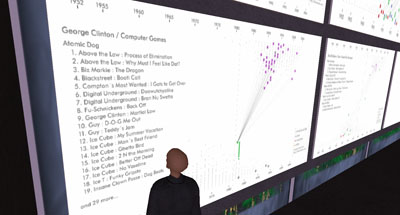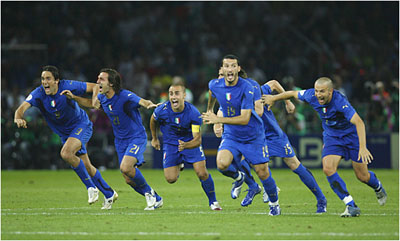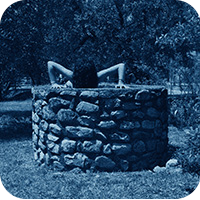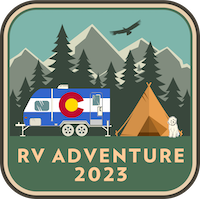Tracking
Today I pulled a $1 bill out of my wallet and saw that it had been stamped with the Where’s George URL. I had read about the dollar bill tracking site before, but this was my first encounter with a tracked bill. So I popped in the serial number and I learned that the bill had previously been in Carmel, Indiana.

Kinda cool, but the real experience was digging into the Where’s George site. It is a huge community of mindbogglingly dedicated bill-trackers. The site has merchandise for sale, forums by region, external fan sites, scoring competitions — things you’d associate with a popular band or videogame, not a site dedicated to tracking denominations of US currency.
But that’s the thing. The map of a bill’s travels around the world isn’t so much the story of the $1 note as it is a visualization of straight-line vectors between fellow dorks. The money is secondary, really. Think of an indiviual bill as little more than a slow-motion chain letter between likeminded, trainspotting money geeks. Once the bill arrives it is plotted on the map and the community grows by one. Where’s George doesn’t track money; it uncovers people who care about tracking money.
Which reminds me of the wine bottle re-gifting from last year. You may recall this as the experiment to see how many times a bottle could be re-gifted. It started in Chicago, jumped once in Chicago, then made its way to Miami where I have lost track of it.* Like Where’s George this small network isn’t so much about where the bottle is as a map of people crass enough to re-gift proudly.
And that’s what’s cool about a social networks. Often the stated reason for the networking (professional connections, hobby information, etc) becomes secondary to the social insight that comes of it. The link makes the node. Not the other way around.
[*] Maybe this Christmas I’ll start a site called Re-Gift Tracker (no, better: Re-Giftr). You’ll be able to enter UPC codes for obviously regifted items and see where they came from. And then there’ll be an interface to Cork’d. And then Amazon. And, and … oh my, Web 2.0 fame and fortune here I come.
Zodiac desktops
I’ve been looking for a good desktop background. But not just anything. Over the years I’ve formed fairly strict requirements.
- Usable. Not sure who first said “wallpaper makes bad stationery,” but it was my guiding principle. Backgrounds need to be easy to work against, contrasting highly with the folders and files that live on it. Photos of children, hot rods, and (sigh) rocket ships generally don’t offer this.
- Widescreen. 1680 x 1050.
- Constrained variation. I wanted the ability to change the background periodically but with some consistency from image to image.
- Cool-looking. Understated references to various aspects of my geekiness score highly.
Well, I found the source material in this amazing collection of images from A Celestial Atlas by Alexander Jamieson published in 1822. The last point was satisified first. These pages are beautiful, simultaneously astronomical and mythological, information design and storybook. But the best part is that they are a calendar sequence tracing the motion of the starry sky over the course of a year — perfect for changing desktops. In order to satisfy requirements one and two I had to do some modification. Inverting the colors immediately produced a pleasant white on blue that blueprintized the prints satisfactorily. Then I reduced opacity to 15% to make contrast with desktop elements generous.
It’s probably no coincidence that I am captivated by these images given my immersion in Tufte’s Beautiful Evidence right now. He makes a great case for the multi-layered beauty of astromonical graphics.

You can download the modified images here. (All 1680 x 1050.)
♈ Aries
♉ Taurus
♊ Gemini
♋ Cancer
♌ Leo
♍ Virgo
♎ – ♏ Libra – Scorpio
♐ Sagittarius
♑ – ♒ Capricorn- Aquarius
♓ Pisces
Also, all in a single zip (8 MB).
There’s always room for improvement of course. I have five displays on my desktop. Ideally they’d all share similar backgrounds that stretch horizontally from one to the next. You could do this with the astronomy prints (stitching the ecliptic into a continuous Mercator armillary across the displays), though only one machine would ever be correct to the current month.
Also, does anyone know if there is a way to have iCal.app schedule desktop image changes?
Inspiration
The Romantic concept of the poet inpsired from seclusion and singular inspiration seems to be alive and well, though once removed. My post on the isolation tank seems to have been the muse for a poem. Here’s an excerpt.
groupmind human searing feedback feedback human searing in human and groupmind and groupmind and and in to groupmind in feedback feedback and and
The weird thing (among many) is that it looks copy-and-pasted, but it isn’t. It’s non-random.
Here’s the full post/poem.
Update: some interesting stats from Chris.
504 is the dominant number in the sequence. If the (perhaps deliberately) malformed “groupmindand,” “nd” and “earing” were normalized then “prayer,” “and,” “feedback,” “groupmind,” “human,” in,” and “to” would all appear 504 times. 504 is also the HTTP status code for “Gateway Time-out.”
Just gets weirder, eh?
Musical floods, musical islands
Last.fm and Pandora are great, no doubt, but for real introduction to new music either you need to work a shift at a college radio station or … befriend a bunch of people with broad taste and an expansive collection. Not being in college, I choose the latter.
In the past nine months I’ve grown my music collection (in sheer filesize) by probably 15-20%. My musical horizons, much more than that. This is almost exclusively due to meeting new people and swapping music. Social networking indeed, but it has all been offline. The Long Tail is a remarkable phenomenon but it is damn long and there’s no roadmap. For me it comes down to it trust in a live human being for recommendations — still my favorite way of experiencing new tunes. Here’s a selection of artists that I’ve taken to in (let’s round up) the last year.
Sufjan Stevens
Four Tet
Boy Least Likely To
Richard Villalobos
My Morning Jacket
Feist
Doves
Chicago Underground Trio
Badly Drawn Boy
Calexico
Imogen Heap
Mojave 3
Sigur Rós
Ladytron
The Arcade Fire
Phoenix
Charlie Hunter
Broken Social Scene
The Kleptones
James T. Cotton
Audion
The Notwist
Nomo
Detroit Experiment
Cornelius
Alex Gopher
Midwest Product
Yagya
Lusine
Lali Puna
Dosh
Claro Intelecto
Casino Versus Japan
Matthew Dear
The Avalanches
DJ Cam
Twine
Mike Relm
Rjd2
DJ Shadow
Tadd Mullinix
Porcupine Tree
Ulrich Schnauss
Tycho
UNKLE
It has been a good year.
And yet. You don’t know what you have until it is gone. A few days ago, the network card on my home fileserver crapped the bed. In an instant, I was cut off from all music and media. Being headless, the Linux machine that I store everything on was totally inaccessible: obviously I couldn’t log into it, but I couldn’t even work on the machine without lugging a monitor out of storage. Before I figured out what was going on I went through the five stages of data loss: (1) Concern, (2) Anxiety, (3) Panic, (4) Lightheaded Otherworldliness, (5) Viewing Sharpened Pencils as Implements of Suicide. But I did lug that monitor and the files are alright. I bought a NIC (for — not kidding — $5) and should have it all back soon.
It has been an interesting period of deprivation. All I can play is what I had loaded on my iPod at the time of the failure. Like being frozen in time, my music queue is now only a sliver of a catalog, a snapshot of what was last updated. It is pleasant, in a way, to have fewer choices. There was a time when you only owned so many CD’s — no vast digital archive, no P2P, satellite radio, or streaming music. You just had to listen to what you had at the time. A few hundred megabytes stuffed into a bottle floating in an ocean that you just can’t drink.
Flashmobbing in the virtual Far East
If all the feel-good talk of virtual community and social networking has you wanting to gag, you’ll be pleased to know that mob justice is alive and well in the metaverse too.
The supremely popular Chinese online role-playing game called “The Fantasy of the Journey West” was recently the scene of a massive virtual protest over the depiction of what looked like a Japanese imperial flag inside a traditional Chinese government office. But that makes it sound halfway rational. You have to see the screen grabs of thousands of huddled avatars spewing nationalist rage to fully appreciate the lunacy.

EastSouthWestNorth has the blow-by-blow, while Salon attempts to sort out the mess.
Sheesh, some people sure get upset about flags, you know? Must be an election year in China. No, wait …
Wired up in my capsule to the moon
Last year I wrote about taking a waterproof iPod and headphones into a sensory deprivation chamber. I chose Biosphere’s album Autour de la Lune. It was a fascinating experiment. Borderline hallucinogenic and deeply relaxing, the total sensory focus on the ultra-minimal tones of Autour de la Lune was the closest I had ever come to being completely lost in sound. After that session I started wondering how linked my own body rhythms had become to the music during the hour of sensory focus.
Well, fast forward almost a year. A few weeks ago I went back to the tanks armed with a heartrate monitor in addition to the waterproof iPod. In I went, on came the album, and the simple EKG started logging.
The superimposed waveform on the heartrate graph is an example of info design awful enough to make Edward Tufte flatline. No, I’m not implying that the sonic peaks and valleys of the music corresponded with spikes (no valleys, thank goodness!) of my heartrate. Obviously the heartbeats per minute units have no relavance to the waveform heights. However, the time axis is in synch. So, you can see what my heartrate was at any moment in the music (song titles in bold black at top).
What to make of it? First the outliers at either end can be discarded as they are my elevated heart rate from entering and leaving the isolation tank. (It ain’t easy with all that gear and warm, hypersalty water sloshing around your nude body.) The first thirteen minutes are somewhat erratic as I’d expect from the acclimation phase. You bump the sides and basically spend a bit of time just calming down. Still, the music during this phase was somewhat erratic too. There’s not enough data to correlate my heartrate with the music, of course, but both do even out around minute fourteen. The end of the first song, Translation, is a complex, consistent drone and it is right at this point that my heartrate starts to level off. During Rotation, a “spikier” collection of tones, my heart rate became more variable again. The most interesting phase is next with the song Modifié. This is one of the subtlest tracks on the album and here my heartrate drops to its lowest point of the whole session. This is the hypnagogic state, the time when you can’t tell if you are asleep or awake, dreaming or thinking — the reason you’re in the chamber to begin with. From there, the heartrate warbles a bit (during Vibratoire, appropriately) and then begins a steady clim back up during Déviation.
Autour de la Lune (“Around the Moon”) is a concept album/tone poem heavily influenced by Jules Vernes’ novel of the same name. The novel, one of the earliest examples of science fiction, is a continuation of the story of a mission to the moon from his first lunar novel “From the Earth to the Moon“. I probably won’t get any closer to the actual surface of the moon than Verne did, but then again in the sensory deprivation tank I was strapped up with medical telemetry all astronaut-like, floating in a capsule of total isolation on my way to a place far away. My trip around the moon.
A word of warning. Both times I’ve done this I’ve had some pressure issues in my head and ringing in my ears for a few days afterward. I am not sure if it is due to the insert headphones, the low droning of the music, the saltwater, or a combination of all these factors. But it is annoying. The perils of spaceflight.
See also My Beating Blog, an interesting experiment where each post is accompanied by correspoding heartrate data.
Isn’t that spatial?

Nothing left to accomplish now that I’m the subject of a podcast, I guess.
VerySpatial – Episode 51 [16.2 MB, MP3 format]
VerySpatial is the work of three really interesting folks at West Virginia University who focus on geospatial technologies. Sue (pictured right), Jesse, and Frank interviewed me last week after they came across the press hoopla for The Forbidden City: Beyond Space and Time project.
Beware: none of my prolixity or verbal stutters have been edited out. Massive rambling dead ahead!
Azzurri per sempre!
They should bronze this pose, Iwojima-like, and plop it out in front of the Colosseum.
Update: if they can make a fresco why not a sculpture?
Today in Italian news …
![]()
Well, it looks like my daughter will have to be the second woman of Italian-American descent to go into space. Crap! (Congratulations to Lisa Caputo Nowak.)
In other news, the battle of the European viticultural powerhouses will be staged on Sunday. Viva Italia! Screw France like they were the Gaul-toys of the Roman Empire!
Eleven months ago I received the results of my participation in The Genographic Project, the National Geographic-IBM partnership to help complete the map of genetic diversity that accounts for humankind’s migration around the world. Since then I’ve been contacted by lots of people also involved in the project who, presumably, are googling M172, the name of mutation that we share. My patrilineal genealogical line intersects the genetic data in southern Italy. But the members of my extended “family” (according to comments on this site and private e-mail) live in Iran, Hungary, India, and Croatia. Amazing to even feel a shred of familial relation to these perfect strangers.
And lastly, the Little Italy, Chicago entry on Wikipedia is but a stub. This is criminal. Or rather, the fact that I don’t have time enough to flesh it out is criminal. I owe it to my grandfather’s stomping ground to edit this, no? Must do this. Must.
The a-ha! moment

Above, last night’s opening in Second Life of Jesse Kriss’s History of Sampling visualization (SLURL: Ars Virtua New Media Gallery).
A few weeks ago I moderated a panel of artists and technologists at the Aldrich Contemporary Art Museum whose aim was basically to complicate the distinction between the two categories of panelists. It was a great disussion in a superb environment: the Aldrich is a first-rate, forward-thinking museum in Ridgefield, CT, a place you’d never expect it. The germ of the discussion was creativity. How are technical creativity and artistic creativity — “innovation” to be buzzword-compliant — related? Are they analogous? If so, where do the similarities break down?
We stacked the deck a bit by involving technical folks whose work was clearly artful and artists whose medium was heavily technologized, but the audience itself, also involved in the discussion, were from a wide range of both backgrounds. The goal of the day was to try to isolate, such as possible, the moment of inspiration — the moment when you knew you had something worthwhile. How did this come about? Almost everyone said the idea came first and only then was the tool sought to make it real. One of IBM researchers said that if he could perform his complex visualizations with a pencil he would.
This surprised me. One of the great things about technology, it seems to me, is its extensibility in ways not intended by the designer. I figured both groups would see this as inspiration in itself. The artist, perhaps not understanding fully the capabilities of a digital tool, cajoles (even breaks) it in unique ways — while the geek, knowing intimately the capabilities of a particular tool, hacks or applies it in unique ways. Admittedly tool-inspired creativity is only one route, but no one on the panel seemed to put much stock in it. Maybe I’m wrong, but can I be the only person who has loaded an application and thought “Gee, I’d love to make it do X.” The creativity, in part, comes in making the tool behave “improperly.”
The panelists were a great bunch. See for yourself.
See also Geeks in the Gallery, unrelated to the Aldrich event but very relevant to the discussion.















